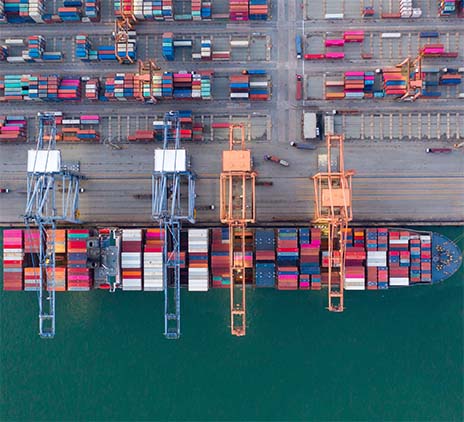-
Why Grant Thornton
Whether you’re growing in one market or many, looking to operate more effectively, managing risk and regulation, or realising stakeholder value, our firms can help.
-
Culture and experience
Grant Thornton’s culture is one of our most valuable assets and has steered us in the right direction for more than 100 years.
-
Global scale and capability
Beyond global scale, we embrace what makes each market unique, local understanding on a global scale.
-
Join our network
In a world that wants more options for high quality services, we differentiate in the market to grow sustainably in today’s rapidly changing environment.
-
Leadership governance and quality
Grant Thornton International Ltd acts as the coordinating entity for member firms in the network with a focus on areas such as strategy, risk, quality monitoring and brand.
-
Africa
24 member firms supporting your business.
-
Americas
31 member firms, covering 44 markets and over 20,000 people.
-
Asia-Pacific
19 member firms with nearly 25,000 people to support you.
-
Europe
53 member firms supporting your business.
-
Middle East
8 member firms supporting your business.
-
Business consulting services
Our business consulting services can help you improve your operational performance and productivity, adding value throughout your growth life cycle.
-
Business process solutions
We can help you identify, understand and manage potential risks to safeguard your business and comply with regulatory requirements.
-
Business risk services
The relationship between a company and its auditor has changed. Organisations must understand and manage risk and seek an appropriate balance between risk and opportunities.
-
Cybersecurity
As organisations become increasingly dependent on digital technology, the opportunities for cyber criminals continue to grow.
-
Forensic services
At Grant Thornton, we have a wealth of knowledge in forensic services and can support you with issues such as dispute resolution, fraud and insurance claims.
-
Mergers and acquisitions
We work with entrepreneurial businesses in the mid-market to help them assess the true commercial potential of their planned acquisition and understand how the purchase might serve their longer-term strategic goals.
-
Recovery and reorganisation
Workable solutions to maximise your value and deliver sustainable recovery.
-
Transactional advisory services
We can support you throughout the transaction process – helping achieve the best possible outcome at the point of the transaction and in the longer term.
-
Valuations
We provide a wide range of services to recovery and reorganisation professionals, companies and their stakeholders.
-
Sustainability advisory
We can assist you with a variety of sustainability advice depending on your needs, ranging from initial strategy development, reporting and compliance support, through to carbon measurement and management.

-
IFRS
At Grant Thornton, our IFRS advisers can help you navigate the complexity of financial reporting from IFRS 1 to IFRS 17 and IAS 1 to IAS 41.
-
Audit quality monitoring
Having a robust process of quality control is one of the most effective ways to guarantee we deliver high-quality services to our clients.
-
Global audit technology
Our global assurance technology platform provides the ability to conduct client acceptance, consultations and all assurance and other attestation engagements.
-
Sustainability assurance
Our sustainability assurance services are based on our global network of specialists, helping you make more efficient decisions for the good of your organisation.

-
Corporate and business tax
Our trusted teams can prepare corporate tax files and ruling requests, support you with deferrals, accounting procedures and legitimate tax benefits.
-
Direct international tax
Our teams have in-depth knowledge of the relationship between domestic and international tax laws.
-
Global mobility services
Through our global organisation of member firms, we support both companies and individuals, providing insightful solutions to minimise the tax burden for both parties.
-
Indirect international tax
Using our finely tuned local knowledge, teams from our global organisation of member firms help you understand and comply with often complex and time-consuming regulations.
-
Transfer pricing
The laws surrounding transfer pricing are becoming ever more complex, as tax affairs of multinational companies are facing scrutiny from media, regulators and the public
-
Africa tax desk
A differentiating solution adapted to the context of your investments in Africa.
-
Sustainability tax
Through our sustainability tax advisory services, we can advise how environmental taxes, incentives, and obligations can impact your progress, requiring alignment with governmental and legislative pressures.

-
 Banking Holding banking to account: the real diversity and inclusion pictureWe explore how the banking sector can continue to attract, retain and nurture women to build a more diverse and inclusive future.
Banking Holding banking to account: the real diversity and inclusion pictureWe explore how the banking sector can continue to attract, retain and nurture women to build a more diverse and inclusive future. -
 Sustainability From voluntary to mandatory ESG: How banks can future-proof their operationsAs we move from voluntary ESG initiatives to mandatory legislation, we explore what the banking sector needs to prioritise.
Sustainability From voluntary to mandatory ESG: How banks can future-proof their operationsAs we move from voluntary ESG initiatives to mandatory legislation, we explore what the banking sector needs to prioritise. -
 IFRS IFRS 9 - Audit of Expected Credit LossesGPPC releases The Auditor’s response to the risks of material misstatement posed by estimates of expected credit losses under IFRS 9
IFRS IFRS 9 - Audit of Expected Credit LossesGPPC releases The Auditor’s response to the risks of material misstatement posed by estimates of expected credit losses under IFRS 9 -
 growthiQ Steering your company to long-term successHistory has something important to tell us about the difficulties of steering a business to long-term success – through seismic shifts in technology, consumer demands and product development. With that in mind it’s unsurprising that over half the world’s largest companies in the early 1900s had shut their doors by the late 1990s. Some, however, have endured.
growthiQ Steering your company to long-term successHistory has something important to tell us about the difficulties of steering a business to long-term success – through seismic shifts in technology, consumer demands and product development. With that in mind it’s unsurprising that over half the world’s largest companies in the early 1900s had shut their doors by the late 1990s. Some, however, have endured.
-
 International Financial Reporting Standards Implementation of IFRS 17 ‘Insurance Contracts’The auditor’s response to the risks of material misstatement arising from estimates made in applying IFRS 17 ‘Insurance Contracts’
International Financial Reporting Standards Implementation of IFRS 17 ‘Insurance Contracts’The auditor’s response to the risks of material misstatement arising from estimates made in applying IFRS 17 ‘Insurance Contracts’ -
 IFRS Get ready for IFRS 17After twenty years of development the IASB has published IFRS 17 ‘Insurance Contracts’, find out more.
IFRS Get ready for IFRS 17After twenty years of development the IASB has published IFRS 17 ‘Insurance Contracts’, find out more.
-
 Global business pulse - industry analysis Mid-market recovery spreads to more industriesThe index results for 13 key industries of the mid-market reveals a very uneven recovery from COVID-19
Global business pulse - industry analysis Mid-market recovery spreads to more industriesThe index results for 13 key industries of the mid-market reveals a very uneven recovery from COVID-19 -
 Global business pulse - industry analysis A very uneven recovery across industriesThe index results for 13 key industries of the mid-market reveals a very uneven recovery from COVID-19
Global business pulse - industry analysis A very uneven recovery across industriesThe index results for 13 key industries of the mid-market reveals a very uneven recovery from COVID-19 -
 Global business pulse - Sector analysis Clear patterns of damage from COVID-19 across the industriesThe index results for 12 key sectors of the mid-market reveal just how much or little the various parts of the economy were impacted by COVID-19.
Global business pulse - Sector analysis Clear patterns of damage from COVID-19 across the industriesThe index results for 12 key sectors of the mid-market reveal just how much or little the various parts of the economy were impacted by COVID-19. -
 Not for profit Mission: possible – putting impact at the heart of charityGlobal charitable continues to decline and charity leaders are increasingly looking at their own unique impact journey.
Not for profit Mission: possible – putting impact at the heart of charityGlobal charitable continues to decline and charity leaders are increasingly looking at their own unique impact journey.
-
 Access to finance Raise finance to invest in changePrepare your business to raise finance to invest in change.
Access to finance Raise finance to invest in changePrepare your business to raise finance to invest in change. -
 Private equity firms Private equity in the mid-market: reshaping strategies for 2021When the global COVID-19 pandemic stormed across the globe in early 2020, the private equity sector was hit hard but deals are coming back to the market.
Private equity firms Private equity in the mid-market: reshaping strategies for 2021When the global COVID-19 pandemic stormed across the globe in early 2020, the private equity sector was hit hard but deals are coming back to the market. -
 Mid-market businesses Getting ready for private equity investmentOur specialists explore how private equity firms are now working with their portfolios and how the mid-market can benefit from investment.
Mid-market businesses Getting ready for private equity investmentOur specialists explore how private equity firms are now working with their portfolios and how the mid-market can benefit from investment. -
 Mid-market businesses Myth-busting private equityNervous about partnering with Private Equity? We explore some of the common myths we come across when speaking to mid-market businesses about PE investment.
Mid-market businesses Myth-busting private equityNervous about partnering with Private Equity? We explore some of the common myths we come across when speaking to mid-market businesses about PE investment.
-
 Public sector Helping build the government of tomorrow, todayLearn about the Grant Thornton US public sector team.
Public sector Helping build the government of tomorrow, todayLearn about the Grant Thornton US public sector team. -
 Global business pulse - industry analysis Mid-market recovery spreads to more industriesThe index results for 13 key industries of the mid-market reveals a very uneven recovery from COVID-19
Global business pulse - industry analysis Mid-market recovery spreads to more industriesThe index results for 13 key industries of the mid-market reveals a very uneven recovery from COVID-19 -
 Global business pulse - industry analysis A very uneven recovery across industriesThe index results for 13 key industries of the mid-market reveals a very uneven recovery from COVID-19
Global business pulse - industry analysis A very uneven recovery across industriesThe index results for 13 key industries of the mid-market reveals a very uneven recovery from COVID-19 -
 Global business pulse - Sector analysis Clear patterns of damage from COVID-19 across the industriesThe index results for 12 key sectors of the mid-market reveal just how much or little the various parts of the economy were impacted by COVID-19.
Global business pulse - Sector analysis Clear patterns of damage from COVID-19 across the industriesThe index results for 12 key sectors of the mid-market reveal just how much or little the various parts of the economy were impacted by COVID-19.
-
 Industries European Real Estate PodcastJessica Patel, Tax Partner at Grant Thornton UK speaks with tax partners and directors across the network to share their insights on the real estate market and some of the challenges.
Industries European Real Estate PodcastJessica Patel, Tax Partner at Grant Thornton UK speaks with tax partners and directors across the network to share their insights on the real estate market and some of the challenges. -
 Industries European Real Estate PodcastJessica Patel, Tax Partner at Grant Thornton UK speaks with tax partners and directors across the network to share their insights on the real estate market and some of the challenges.
Industries European Real Estate PodcastJessica Patel, Tax Partner at Grant Thornton UK speaks with tax partners and directors across the network to share their insights on the real estate market and some of the challenges. -
 Global business pulse - industry analysis Mid-market recovery spreads to more industriesThe index results for 13 key industries of the mid-market reveals a very uneven recovery from COVID-19
Global business pulse - industry analysis Mid-market recovery spreads to more industriesThe index results for 13 key industries of the mid-market reveals a very uneven recovery from COVID-19 -
 Global business pulse - industry analysis A very uneven recovery across industriesThe index results for 13 key industries of the mid-market reveals a very uneven recovery from COVID-19
Global business pulse - industry analysis A very uneven recovery across industriesThe index results for 13 key industries of the mid-market reveals a very uneven recovery from COVID-19
-

-
 Global business pulse - industry analysis Mid-market recovery spreads to more industriesThe index results for 13 key industries of the mid-market reveals a very uneven recovery from COVID-19
Global business pulse - industry analysis Mid-market recovery spreads to more industriesThe index results for 13 key industries of the mid-market reveals a very uneven recovery from COVID-19 -
 Global business pulse - industry analysis A very uneven recovery across industriesThe index results for 13 key industries of the mid-market reveals a very uneven recovery from COVID-19
Global business pulse - industry analysis A very uneven recovery across industriesThe index results for 13 key industries of the mid-market reveals a very uneven recovery from COVID-19 -
 Retail How retail is positioning for successCOVID-19 provided some hard lessons for the retail industry. It is time to turn those into sustainable and well executed growth strategies in 2021.
Retail How retail is positioning for successCOVID-19 provided some hard lessons for the retail industry. It is time to turn those into sustainable and well executed growth strategies in 2021.
-
 Technology Mid-market tech companies lead the way on diversity and inclusionWe explore how the mid-market tech sector can continue to build and nurture a culture that’s increasingly more diverse and inclusive for women.
Technology Mid-market tech companies lead the way on diversity and inclusionWe explore how the mid-market tech sector can continue to build and nurture a culture that’s increasingly more diverse and inclusive for women. -
 Tax Resetting global tax rules after the pandemicBusinesses are seeing rising challenges, and finance heads are dealing with a range of new measures. To say the next 12 months are critical for businesses is an understatement.
Tax Resetting global tax rules after the pandemicBusinesses are seeing rising challenges, and finance heads are dealing with a range of new measures. To say the next 12 months are critical for businesses is an understatement. -
 TECHNOLOGY International tax reform: the potential impact on the technology industryIn this article, we’ve summarised key elements of the global tax reform proposals, their potential impact on technology industry and advice from our digital tax specialists on what technology companies can do to prepare.
TECHNOLOGY International tax reform: the potential impact on the technology industryIn this article, we’ve summarised key elements of the global tax reform proposals, their potential impact on technology industry and advice from our digital tax specialists on what technology companies can do to prepare. -
 TMT TMT industry: Fully charged or on standby?Our research revealed five key trends that resonated with Technology, Media and Telecoms (TMT) industry leaders around the world. We asked a panel of our experts from UK, US, India Ireland and Germany, to give us their reaction to the findings.
TMT TMT industry: Fully charged or on standby?Our research revealed five key trends that resonated with Technology, Media and Telecoms (TMT) industry leaders around the world. We asked a panel of our experts from UK, US, India Ireland and Germany, to give us their reaction to the findings.
-
 TMT TMT industry: Fully charged or on standby?Our research revealed five key trends that resonated with Technology, Media and Telecoms (TMT) industry leaders around the world. We asked a panel of our experts from UK, US, India Ireland and Germany, to give us their reaction to the findings.
TMT TMT industry: Fully charged or on standby?Our research revealed five key trends that resonated with Technology, Media and Telecoms (TMT) industry leaders around the world. We asked a panel of our experts from UK, US, India Ireland and Germany, to give us their reaction to the findings. -
 Cybersecurity One size fits nothingTechnology companies must adopt a new approach to digital risk: those that successfully develop a reputation for digital trust by demonstrating an unwavering commitment to cyber security and data privacy will be able to carve out a competitive advantage.
Cybersecurity One size fits nothingTechnology companies must adopt a new approach to digital risk: those that successfully develop a reputation for digital trust by demonstrating an unwavering commitment to cyber security and data privacy will be able to carve out a competitive advantage. -
 Technology, media & telecommunications Why it’s time for a 5G reality checkFigures suggest the mobile sector is maturing. While data usage continues to soar, mobile revenues are expected to flatten out over the next few years.
Technology, media & telecommunications Why it’s time for a 5G reality checkFigures suggest the mobile sector is maturing. While data usage continues to soar, mobile revenues are expected to flatten out over the next few years. -
 GrowthiQ Is blockchain right for your business?Blockchain has been seized upon by the financial services sector, where it is playing a crucial role in tracking and authenticating transactions.
GrowthiQ Is blockchain right for your business?Blockchain has been seized upon by the financial services sector, where it is playing a crucial role in tracking and authenticating transactions.
-
 International business Mid-market businesses lifted by rising tide of optimismOptimism among global mid-market business leaders rose to 67% in the first half of this year and they are markedly more optimistic about their prospects with global optimism having increased by 8%.
International business Mid-market businesses lifted by rising tide of optimismOptimism among global mid-market business leaders rose to 67% in the first half of this year and they are markedly more optimistic about their prospects with global optimism having increased by 8%. -
 Global business pulse - industry analysis Mid-market recovery spreads to more industriesThe index results for 13 key industries of the mid-market reveals a very uneven recovery from COVID-19
Global business pulse - industry analysis Mid-market recovery spreads to more industriesThe index results for 13 key industries of the mid-market reveals a very uneven recovery from COVID-19 -
 Hotels COVID-19: Checking in with the hotel industry one year onCOVID-19 provided some hard lessons for the hotel sector. It is time to turn those into sustainable and well executed growth strategies.
Hotels COVID-19: Checking in with the hotel industry one year onCOVID-19 provided some hard lessons for the hotel sector. It is time to turn those into sustainable and well executed growth strategies. -
 Global business pulse - industry analysis A very uneven recovery across industriesThe index results for 13 key industries of the mid-market reveals a very uneven recovery from COVID-19
Global business pulse - industry analysis A very uneven recovery across industriesThe index results for 13 key industries of the mid-market reveals a very uneven recovery from COVID-19
- By topic
-
Women in Business 2025
For 21 years, the Women in Business report has tracked the proportion of women in senior roles in the mid-market. Progress has been made but with gender equity over 25 years away, that isn’t soon enough.
-
The journey to a sustainable future
The world needs a sustainable mid-market. It’s vital to economies, societies and the planet. Businesses, governments, and other stakeholders must work collaboratively to make sure this vital part of the world economy succeeds.
-
Navigating tariffs
Traditional global export markets continue to shift as tariffs are introduced, presenting a challenge for mid-market firms
-
International business: Mid-market growth and expansion
The mid-market looks to international business opportunities for growth.
-
Women in Business 2025: Impacting the missed generation
The 2025 Women in Business report explores the external pressures and internal drivers that impact gender diversity in senior roles in the mid-market.
-
Women in tech: A pathway to gender balance in top tech roles
Grant Thornton’s 2024 Women in Business data suggests we are far from achieving parity within the mid-market technology sector.
-
Women in leadership: a pathway to better performance
What makes the benefits of gender parity compelling is the impact it can have on commercial performance.
-
Women in Business 2024
2024 marks the 20th year of Women in business where we monitor and measure the proportion of women occupying senior management roles around the world.
-
Women in business: Regional picture
We saw an increase in the percentage of senior management roles held by women, on a global level, but there are some significant regional and country variations.
-
Pathways to Parity: Leading the way
To push towards parity of senior management roles held by women, who leads within an organisation is vital.
-
Generating real change with a long-term focus
The most successful strategy to achieve parity of women in senior management is one which stands alone, independent of an ESG strategy.
-
People at the heart of great business
Businesses have started to put guidelines and incentives in place, focused on driving employees back to the office.
-
The journey to a sustainable future
The world needs a sustainable mid-market. It’s vital to economies, societies and the planet. Businesses, governments, and other stakeholders must work collaboratively to make sure this vital part of the world economy succeeds.
-
Ten considerations for preparing TCFD climate-related financial disclosures
Insights for organisations preparing to implement the International Sustainability Standards Board (ISSB)’s Standards.
-
COP28
COP28 was the first time there has been a global stocktake on progress against the Paris Agreement.
-
Transition Plan Taskforce publishes its final disclosure framework
As organisations in the private sector make commitments and plans to reach net zero, there's a growing need for stakeholders to be able to assess the credibility of their transition plans.
-
Promoting ESG excellence through tax
ESG considerations have never been more important for an organisation’s long-term success, but how can tax be used to add value to an ESG agenda?
-
International business: Mid-market growth and expansion
The mid-market looks to international business opportunities for growth.
-
Top five constraints to international business in the mid-market
Top five major constraints that are testing the mid-market’s ability to grow their businesses internationally.
-
Brand and international marketing – breaking global barriers
Brand has been identified as a key driver of mid-market success when looking to grow and develop international business.
-
The key to international business: Investing in people
How can recruitment and retention help grow international business?
-
Building resilience in international business
Evolving supply chains and trade patterns amid ongoing global uncertainty.
-
Example Financial Statements
The 2025 Interim Financial Statements provide general guidance on preparing interim financial statements in accordance with IFRS Accounting Standards.
-
IFRS 3
Mergers and acquisitions are becoming more common as entities aim to achieve their growth objectives. IFRS 3 ‘Business Combinations’ contains the requirements for these transactions.
-
IFRS 8
Our ‘Insights into IFRS 8’ series considers some key implementation issues and includes interpretational guidance in certain problematic areas.
-
IFRS 16
Are you ready for IFRS 16? This series of insights will help you prepare.
-
IAS 36
Insights into IAS 36 provides assistance for preparers of financial statements and help where confusion has been seen in practice.
-
IFRS 17
Explaining the key features of the Standard and providing insights into its application and impact.
-
Pillar 2
Key updates and support for the global implementation of Pillar 2.
-
Global expatriate tax guide
Growing businesses that send their greatest assets – their people – overseas to work can face certain tax burdens, our global guide highlights the common tax rates and issues.
-
International indirect tax guide
Navigating the global VAT, GST and sales tax landscape.
-
Global transfer pricing guide
Helping you easily find everything you need to know about the rules and regulations regarding transfer pricing and Country by Country reporting for every country you do business with.
Lockdown has disrupted transfer pricing (TP) within multinational enterprises (MNEs). Even as restrictions are gradually eased, there continues to be considerable uncertainty over the risks, circumstances and comparables used to determine arm’s length transfer prices.
The potential for tax authority audit and dispute is heightened by the extent to which what you do now differs from past designations on risk and return. In common instances, limited risk distributors or ‘cost plus’ entities could face challenges from tax authorities if they start to record losses, while higher risk/high profit operations appear to have been insulated. In the long-term, you could also face retrospective challenge as tax authorities come under pressure from cash-strapped governments to recoup some of today’s state aid and lost tax revenues.
Drawing on the TP issues raised by our clients from around the world, our TP experts highlight the dilemmas your business could face in determining arm’s length transfer prices, the ramifications and potential risks. We conclude by setting out six practical ways to navigate through the TP minefield.
Of the many challenges your business faces right now, TP might not seem like the most pressing. Yet, it impinges on many of the issues in most urgent need of addressing, from cost management and stabilising income streams to how to use government grants effectively. Moreover, the TP decisions taken during 2020 could come back to haunt you in the coming years as tax authorities look retrospectively for opportunities to boost the tax take from MNEs.
 “The transfer pricing implications should be considered up front as part of key business decisions. If functions, risks or assets are transferred overseas to consolidate business positions, for example, how will this affect transfer pricing? How might changes in inter-company financing impact the risks and other factors influencing the transfer pricing model?”
“The transfer pricing implications should be considered up front as part of key business decisions. If functions, risks or assets are transferred overseas to consolidate business positions, for example, how will this affect transfer pricing? How might changes in inter-company financing impact the risks and other factors influencing the transfer pricing model?”
Leslie Van den Branden, Partner, Grant Thornton Belgium
What then are the developments that could affect your TP policies and their management?
One of the basic principles of TP is that it should conform, at least indirectly, to some form of observable transaction or reflect what two unrelated parties would reasonably pay in an arm’s length transaction. 2020 offers little observable precedent for either approach.
“Today’s sharp falls in turnover and disruption to supply chains are taking transfer pricing into new and uncharted territory. There is also little or no precedent to help determine what an unrelated party would expect in an arm’s length transaction. Transfer pricing policies are therefore likely to need thorough review, possible revision and clear substantiation to support any new determinations.”
Wendy Nicholls, Joint global head of transfer pricing, Grant Thornton
So, what does this all mean in practice?
Issue 1: TP policies opened up to challenge
Many businesses saw revenues grind to a halt as lockdowns were imposed, but staff and other costs didn’t go away. From a TP perspective, one of the dilemmas has been that operations typically identified as low risk such as assembly or warehousing may now be running at a significant loss.
While many third party operators may also be suffering losses, and intra-group pricing should reflect the extraordinary economic realities as far as possible, you would still need to justify why the risks have changed and why they might not have been fully reflected in pre-crisis determinations.
 “Transfer pricing isn’t an exact science. Business strategies are subject to change, especially in a crisis situation. If you decide that revisions to your transfer pricing policies are needed in line with the arm’s length principle, the decision should be documented and substantiated properly.”
“Transfer pricing isn’t an exact science. Business strategies are subject to change, especially in a crisis situation. If you decide that revisions to your transfer pricing policies are needed in line with the arm’s length principle, the decision should be documented and substantiated properly.”
Charles Marais, Partner, Grant Thornton Netherlands
Implications
The danger is twofold. First, tax authorities may now question whether some of the limited risk operations were such a low risk within ‘cost plus’ evaluations in the past, or whether they should have made more profit in the ’good years’. Second, how much of the losses you are now incurring can be allocated to those low-risk activities, or will the loss claims be rejected?
The reverse is also true for ‘super profit drivers’ such as entities engaged in innovation or owning other intellectual property, which paradoxically may not see as much immediate operational loss as trading entities. Have the risks borne and rewards allocated to the high risk/profit IP sources been justified from a TP perspective? And if losses are now being borne by the low-risk operations, which may have paid little tax in the past, are you at risk of hemorrhaging tax because you are unable to relieve the losses?
A big danger is that the perceived TP anomalies highlighted by the COVID-19 emergency in areas such as whether the risk designation is justified could lead to tax authority investigations. These could involve multiple authorities, with different incentives: the head office country may be very keen not ‘share the pain’ but the subsidiary jurisdiction may want to preserve its positive returns.
As tax authorities look to increase revenues in the coming years, the anomalies in TP designations could come under intense scrutiny. What you do now therefore has to be fully justifiable, with a close eye on the potential for retrospective challenge. The scrutiny could range from the production of goods and provision of services to IP and financing – in other words, virtually any type of transaction.
While the situation is extraordinary, the risks vary according to function and where they are located. Failure to re-evaluate could have a significant impact on the country where the risks are borne.
Equally, where risk designations are changed, this will have repercussions later on. For example, an operation in which the downside risks are increased would generally be expected to earn a higher reward going forward.
 “Although tax authorities should make accommodations given the nature of the crisis, some may not. Faced with this possibility, you should review each tax authority’s policy and prior history with your company.”
“Although tax authorities should make accommodations given the nature of the crisis, some may not. Faced with this possibility, you should review each tax authority’s policy and prior history with your company.”
Pascal Luquet, Partner, Grant Thornton France
Issue 2: When does normal begin again?
From a TP perspective, the period during lockdown has clearly been exceptional. But what about the rest of 2020? As reopening gathers pace, some businesses are already seeing a significant uptick in revenues. But for most it may be months and even years before they get back to anything approaching normal.
“Profit-based transfer pricing approaches assume that profits are made and that there are reliable cost and sales forecasts. They are not realistic. Sudden changes in sales or production capacity utilisation will lead to unexpected losses that need to be reported properly.”
Brad Rolph, Joint global head of transfer pricing, Grant Thornton
Implications
The challenge is determining the duration of the exceptional period for TP purposes and when it could be deemed to have ended. It’s also important to assess whether benchmarks conducted in the past remain applicable or whether new benchmarks should be undertaken for the period during and after COVID-19.
While many businesses are now opening up, they are still feeling the impact of restrictions such as social distancing. It’s therefore difficult to know how the results for the rest of this and the next financial years will play out. Scenario modelling could be applied, but it may be well beyond the year-end before impacts and durations can be determined with any certainty. It may therefore be necessary to divide periods of account from a TP perspective into before, during and after the emergency.
Groups should look to adopt reasonable arrangements to align transfer pricing policies with the changing realities within the business. Examples include working out how to reflect the different distribution of profit and loss within the supply chain. Further priorities include working out to what extent a temporarily paused or scaled back operation should be remunerated differently to when it was fully up and running.
Issue 3: Questions about the allocation of state support
TP management is complicated by state aid such as government subsidies for staff costs. Governments naturally want their money to be used to support local jobs.
As an MNE, you also face the challenge of how revenues and subsidies are allocated from one state to another. If one state makes good your losses through furlough schemes or business loans, is it reasonable that another less generous state should benefit when (post-support) profits and losses are allocated across the whole supply chain?
Implications
As many operations deemed low risk from a TP perspective such as warehousing are also relatively labour intensive, determining who takes the benefits of the subsidies and who bears the losses opens up significant risk of challenge.
It’s important to ensure that TP and other tax decisions, calculations and payments are aligned.
 “Current transfer pricing policies may not reflect the commercial realities of disrupted supply chains. As a result, profits and expenses might not be allocated in the appropriate jurisdiction. Revisions will be needed to correct this misalignment.”
“Current transfer pricing policies may not reflect the commercial realities of disrupted supply chains. As a result, profits and expenses might not be allocated in the appropriate jurisdiction. Revisions will be needed to correct this misalignment.”
Paolo Besio, Partner, Bernoni Grant Thornton
The way forward
Although nothing in the past really compares to the full lockdown seen in 2020, the 2008 financial crisis provides some precedent for the kind of revenue disruption seen at present. One of the most important lessons from the financial crisis is that audits may well take place years after the event and therefore TP decisions need to be documented promptly so as to stand up to scrutiny.
Industries are coming together to determine the foundations for best practice. However, their endeavours are hampered by the lack of contemporaneous benchmarks and comparables upon which to base their recommendations.
The OECD is also looking at the transfer pricing issues raised by the COVID-19 emergency. Whilst consensus is difficult and the guidance is likely to be fairly generic, there is acknowledgement that countries will face ‘increased revenue needs’ and the OECD has said that ‘in a post-crisis environment, it is likely that addressing the tax challenges of the digitalisation of the economy and ensuring that MNEs pay a minimum level of tax will be of even higher importance’.[i]
Your business is therefore being forced to make prompt decisions based on imperfect information that will later be scrutinised with hindsight. How can you address these difficult questions?
1. Review your risk appetite
As the squeeze on revenues and available cash increases, we’re seeing a significant increase in the risk appetite regarding TP within many businesses. When survival is at stake, this may be one way to hold onto and/or release funds. At the same time, the risks of challenge from surrounding TP have been increased by the current situation. This is a difficult balance.
 “Companies appetite for transfer pricing risk may change as they look to conserve cash. Where these companies may have conservatively targeted the median operating margin previously, they may now designate a significantly lower, or zero returns in some jurisdictions due to cash constraints. While this may be a risk they are prepared to take now, the tax authorities will be looking for ways to recoup lost revenues. Their prime targets are likely to include businesses that have significantly changed their transfer price risk appetite and approach.”
“Companies appetite for transfer pricing risk may change as they look to conserve cash. Where these companies may have conservatively targeted the median operating margin previously, they may now designate a significantly lower, or zero returns in some jurisdictions due to cash constraints. While this may be a risk they are prepared to take now, the tax authorities will be looking for ways to recoup lost revenues. Their prime targets are likely to include businesses that have significantly changed their transfer price risk appetite and approach.”
Jason Casas, Partner, Grant Thornton Australia
2. Accept that many key decisions will be provisional
Continuing uncertainty over the duration and impact of COVID-19 on your business mean that many decisions will need to be provisional at this stage. They would then be subject to change and finalisation at year-end and beyond.
 “As ex-post testing may not provide sufficiently substantiated results, it’s important to prepare and document ex-ante forecasts to defend the arm’s length character of crisis adjustments made.”
“As ex-post testing may not provide sufficiently substantiated results, it’s important to prepare and document ex-ante forecasts to defend the arm’s length character of crisis adjustments made.”
Jean-Nicolas Bourtembourg, Partner, Grant Thornton Luxembourg
3. Take account of subsidies
Ensure that subsidies for staff and other overheads and operating costs are fully factored into TP decisions.
 “A big question for MNEs is who takes the loss and who benefits from any subsidies. Country-by-country reporting will allow governments to see whether or not the subsidies they provide are supporting jobs and operations within their jurisdictions.”
“A big question for MNEs is who takes the loss and who benefits from any subsidies. Country-by-country reporting will allow governments to see whether or not the subsidies they provide are supporting jobs and operations within their jurisdictions.”
Juan Martínez, Partner, Grant Thornton Spain
4. Reassess benchmarks
Judge whether the benchmarks used to determine TP treatment are still valid and, if not, how they can be updated. The exceptional nature of the current situation inevitably increases the subjectivity of your decisions. For this reason, it’s important to ensure that clear justifications and documentation are in place. You might also consider adjusting benchmarks to include loss makers and make comparability adjustments based on the reduction in business being reported by similar companies in your industry. It may even be necessary to look at alternative approaches to determining ranges of arm’s length prices, such as economic game theory to model the behaviour of unrelated parties in this unprecedented situation.
 “Although taxpayers can expect heightened scrutiny from tax authorities, it’s better to alter and document transfer prices to align with new arm’s-length realities than to continue legacy transfer pricing approaches that rely on pre-pandemic expectations.”
“Although taxpayers can expect heightened scrutiny from tax authorities, it’s better to alter and document transfer prices to align with new arm’s-length realities than to continue legacy transfer pricing approaches that rely on pre-pandemic expectations.”
Steven Wrappe, National technical leader, transfer pricing, Grant Thornton US
5. Keep a real-time record
Although finalised decisions on TP treatment may not be possible until year-end, it’s still important to record data, document decisions/justifications in real-time and include these in your monthly management reporting pack. This will help to ensure that the risks are clear and being considered. You can then make a better case if you come under investigation in the years to come.
6. Ensure consistency
Make sure decisions over TP are consistent with, and take account of, the knock-on impacts on other key tax and business management priorities including financing, VAT and government relations.
Conclusion: A stitch in time saves nine
As supply and demand are disrupted, so too is the basis for TP. Clearly TP designations will change as operations are scaled back and revenues dip. But simply saying that these are exceptional times and adjusting accordingly aren’t enough as TP approaches used now could invite tax authority challenge of both pre-pandemic and post-pandemic designations. Determining and defending approaches will be much easier if TP is forecasted, managed and documented as a real-time exercise rather than retrospectively.
If you would like to discuss any of the points raised in this article, please contact your usual Grant Thornton contact, local member firm or one of the authors listed below.
|
Australia
Jason Casas |
Luxembourg
Jean-Nicolas Bourtembourg |
|
Belgium
Leslie Van den Branden |
The Netherlands
Charles Marais |
|
Canada
Brad Rolph |
Spain
Juan Martínez |
|
France
Pascal Luquet |
United Kindom
Wendy Nicholls |
|
Italy
Paolo Besio |
United States
Steven Wrappe |
[i] www.oecd.org - Tax and fiscal policy in response to the Coronavirus crisis: Strengthening confidence and resilience


